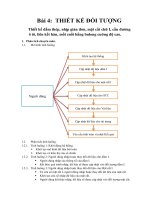Iterator, composite (THIẾT kế đối TƯỢNG SLIDE)
Bạn đang xem bản rút gọn của tài liệu. Xem và tải ngay bản đầy đủ của tài liệu tại đây (769.32 KB, 51 trang )
The Iterator and
Composite Patterns
Well-Managed Collections!
1
Breaking news…..
• The Objectville Diner and Pancake House have merged!
Menus must be merged and have their separate identities!
Owners agree on the implementation of the MenuItems.
public class MenuItem {
String name;
String description;
boolean vegetarian;
double price;
public MenuItem(String name, String description,
boolean vegetarian, double price) {
// code here
}
// set of getter methods to get access to the fields.
2
Menu Implementations - Pancake House
public class PancakeHouseMenu {
ArrayList menuItems;
public PancakeHouseMenu() {
menuItems = new ArrayList();
Uses an ArrayList, so the
menu can be easily expanded.
addItem("Regular Pancake Breakfast",
"Pancakes with fried eggs, sausage", false, 2.99);
addItem("Blueberry pancakes",
"Pancakes made with fresh blueberries", true, 3.49);
// other items
}
}
public void addItem(String name, String description,
boolean vegetarian, double price) {
MenuItem menuItem = new MenuItem(name, description,
vegetarian, price);
menuItems.add(menuItem);
}
To add a menuItem public ArrayList getMenuItems() {
create a MenuItem
return menuItems;
object, add it to the
}
ArrayList
// other methods
3
Dinner Menu Implementations
public class DinerMenu {
static final int MAX_ITEMS = 6;
int numberOfItems = 0;
MenuItem[] menuItems;
Uses an array of menu item
public DinerMenu() {
menuItems = new MenuItem[MAX_ITEMS];
addItem("Vegetarian BLT",
"(Fakin') Bacon with lettuce & tomato on whole wheat", true,
2.99);
// other menu items
}
public void addItem(String name, String description,
boolean vegetarian, double price) {
MenuItem menuItem = new MenuItem(name, description, vegetarian,
price);
if (numberOfItems >= MAX_ITEMS) {
System.err.println("Sorry, menu is full!");
} else {
menuItems[numberOfItems] = menuItem;
numberOfItems = numberOfItems + 1;
}
}
public MenuItem[] getMenuItems() {
return menuItems;
4
What’s the problem with having two
different menu representations?
• What would it take to implement the functionality
that a Java-enabled Waitress may want:
– printMenu(): prints every item on the menu
– printBreakfastMenu(): prints just the breakfast
items
– printLunchMenu(): prints just the lunch items
– printVegetarianMenu(): prints all the vegetarian
items
– isItemVegetarian(name): given the name of the
item, returns true if vegetarian, false otherwise
5
Implementing the Waitress
1. To print all the items on each menu:
The methods look the same,
but return different types -ArrayList versus Array
PancakeHouseMenu pancakeHouseMenu = new
PancakeHouseMenu();
ArrayList breakfastItems =
pancakeHouseMenu.getMenuItems();
DinerMenu dinerMenu = new DinerMenu();
lunchItems
dinerMenu.getMenuItems();
2.MenuItem[]
Print the items
from the= PancakeHouseMenu
and the
DinerHouseMenu
- Need
ArrayList and Array respectively.
for
(inttoj loop
= 0;over
j < the
breakfastItems.size();
j++){
MenuItem menuItem = (MenuItem)breakfastItems.get(j);
System.out.println(menuItem.getName());
// print out the description, vegetarian, and price
}
for (int j = 0; j < lunchItems.length; j++) {
MenuItem menuItem = lunchItems[j]; }
3. Implementing the other methods is a variation on this theme.
If another restaurant is added in, we would need three loops!
6
What now?
• Implementations can not be modified
– Requires rewriting a lot of code in each respective
menu
• Need: same interface for menus
– getMenuItems() need to return a common object
type
• How do we do that?
7
What now?
•
One of the key principles is:
"Encapsulate what varies".
What varies here?
•
Iteration caused by different collections of objects
returned from the menus.
•
Can we encapsulate this?
1. To iterate through the breakfast items we use
size() and get() methods on the Arraylist.
2. To iterate through the lunch items we use the array
length field and the array subscript notation
on MenuItem array.
8
Simple Iterator
• What if we create an object, an Iterator, that
encapsulates how we iterate through a collection of
objects.
Iterator iterator = breakfastMenu.createIterator();
while (iterator.hasNext()) {
MenuItem menuItem = (MenuItem) iterator.next();
}
• Similarly,
Iterator iterator = dinerMenu.createIterator();
while (iterator.hasNext()) {
MenuItem menuItem = (MenuItem)iterator.next();
}
9
Meet the Iterator Pattern
• The Iterator Design Pattern relies on an interface
called the Iterator interface.
<<Interface>>
Iterator
hasNext()
next()
A possible Iterator
interface
public interface Iterator {
boolean hasNext();
Object next();
}
PancakeHouseMenuIterator DinerMenuIterator
hasNext()
next()
hasNext()
next()
10
Using the Iterator for the Diner
Menu
public class DinerMenuIterator implements Iterator {
MenuItem[] items;
int position = 0;
position maintains the current position
of the iteration over the array.
public DinerMenuIterator(MenuItem[] items) {
this.items = items;
The constructor takes the array of menu
}
items we are going to iterate over.
public Object next() {
MenuItem menuItem = items[position];
position = position + 1;
The next() method returns the next item
return menuItem;
in the array and increments the position.
}
{
}
public boolean hasNext() {
if (position >= items.length || items[position] == null)
}
return false;
} else { return true; }
The hasNext() method checks to see if
we’ve seen all the elements of the array
11
Reworking the Diner Menu with
Iterator
public class DinerMenu {
static final int MAX_ITEMS = 6;
int numberOfItems = 0;
MenuItem[] menuItems;
// constructor here
// addItem here
We’re not going to need the getMenuItems()
method anymore and in fact we don’t want it
because it exposes our internal implementation!
public MenuItem[] getMenuItems() {
return menuItems;
}
}
creates a
DinerMenuIterator from
the menuItems array and
returns it to the client.
public Iterator createIterator() {
return new DinerMenuIterator(menuItems);
}
// other menu methods here
We’re returning the Iterator interface.
The client doesn’t need to know how the menuItems are maintained in
the DinerMenu, nor how the DinerMenuIterator is implemented.
It just needs to use the iterators to step through the items in the menu.
12
Fixing up the Waitress Code
public class Waitress {
Waitress takes the
PancakeHouseMenu pancakeHouseMenu;
two objects as before
DinerMenu dinerMenu;
public Waitress(PancakeHouseMenu pancakeHouseMenu,
DinerMenu dinerMenu) {
this.pancakeHouseMenu = pancakeHouseMenu;
this.dinerMenu = dinerMenu;
The printMenu() creates
}
two iterators one for each
menu
public void printMenu() {
Iterator dinerIterator = dinerMenu.createIterator();
System.out.println("\nLunch");
printMenu(dinerIterator);
// similar set of statements for Breakfast menu
}
}
public void printMenu(Iterator iterator) {
while (iterator.hasNext()) {
MenuItem menuItem = (MenuItem) iterator.next();
// print it out
}
}
Back to one loop! Here is where the printing occurs.
13
What have we done?
•
The Menus are not well
encapsulated; we can see the
Diner is using an ArrayList and
the Pancake House an Array.
•
We need two loops to iterate
through the MenuItems.
•
•
The Waitress is bound to
concrete classes (MenuItem[]
and ArrayList)
The Waitress is bound to two
concrete Menu classes, despite
their interfaces being almost
identical.
•
The Menu implementations are
now encapsulated. The
Waitress has no idea how the
Menus hold their collection of
menu items.
•
All we need is a loop that
polymorphically handles any
collection of items as long as it
implements the iterator.
•
The Waitress now uses an
interface (Iterator).
•
The Menu interfaces are now
exactly the same and uh, oh,
we still don’t have a common
interface, which means the
Waitress is still bound to two
concrete Menu classes.
14
Bird’s Eye View of Current Design
The Iterator allows the Waitress to be decoupled from the actual
implementation of the concrete classes. She does not need to know if
a Menu is implemented with an Array or ArrayList!
All she cares is that she can get an iterator to do her iterating.
The waitress is still bound to
two concrete Menu classes
Solution: define a common
interface for two classes
<<Interface>>
PancakeHouseMenu
Waitress
menuItems
printMenu()
createIterator()
<<use>>
Iterator
hasNext()
next()
DinerMenu
menuItems
createIterator()
<<create>>
PancakeHouseMenuIterator
DinerMenuIterator
hasNext()
next()
hasNext()
next()
<<create>>
The Iterator gives us a way to step through the elements of an aggregate without having the aggregate
clutter its own interface with a bunch of methods to support traversal of its elements. It also allows the
implementation of the iterator to live outside the aggregate --- in other words, we ‘ve encapsulated the15
iteration.
The Iterator Pattern Defined
The Iterator Pattern provides a way to access the elements
of an aggregate object sequentially without exposing its
underlying implementation.
<<Interface>>
<<Interface>>
Aggregate
Client
hasNext()
next()
createIterator()
ConcreteAggregate
createIterator()
Iterator
<<create>>
ConcreteIterator
hasNext()
Next()
The Iterator places the task of traversal on the iterator object, not on the
aggregate, which simplifies the aggregate interface and implementation, and
places the responsibility where it should be.
16
Design Principle: Single Responsibility
A class should have only one reason to change.
• Every responsibility of a class is an area of potential
change. More than one responsibility means more
than one area of change.
• This principle guides us to keep each class to a
single responsibility.
• We have studied the principle of single responsibility
at the module level.
What is it?
17
Brain Power
18
The java.util.Iterator
• The java.util.Iterator interface supports the
Iterator pattern that we have discussed thus far.
• The Java Collections Framework – provides a set of
classes and interfaces, including ArrayList,
Vector, LinkedList, Stack and
PriorityQueue.
• All of these classes implement the Collection
interface, and provide a method iterator() to
return an instance of the java.util.iterator to
iterate over the collection.
19
Using java.util.Iterator
<<Interface>>
<<Interface>>
Waitress
Menu
printMenu()
createIterator()
PancakeHouseMenu
menuItems
DinerMenu
menuItems
createIterator()
createIterator()
hasNext()
next()
remove()
PancakeHouseMenuIterator
hasNext()
next()
remove()
<<create>>
These now implement
the Menu interface
<<use>>
java.util.Iterator
DinerMenuIterator
hasNext()
next()
remove()
<<create>>
using the
ArrayList iterator
supplied by
java.util.
DinerMenu returns a
DinerMenuIterator from its
createIterator() method because
that’s the kind of iterator required to iterate
over its Array of menu items.
20
DinerMenuIterator implement
java.util.Iterator
public class DinerMenuIterator implements Iterator {
MenuItem[] list;
int position = 0;
public Object next() { // the same of above }
public boolean hasNext() { // the same of above }
public void remove() {
if (position <= 0) {
throw new IllegalStateException(
"You can't remove an item until " +
"you've done at least one next()");
}
if (list[position - 1] != null) {
for (int i = position - 1; i < (list.length - 1); i++) {
list[i] = list[i + 1];
}
list[list.length - 1] = null;
}
}
}
21
Iterator in Java 5
• Iterators and Collections in Java 5:
– Added support for iterating over Collections so that
you don’t even have to ask for an iterator!
• Includes a new form of for statement -- for/in
– Lets you iterate over a collection or an array without
creating an iterator explicitly.
ArrayList items = new ArrayList();
items.add(new MenuItem("Pancakes",
"delicious pancakes", true, 1.59);
items.add(new MenuItem("Waffles", "yummy waffles", true,
1.99);
items.add(new MenuItem("Toast", "perfect toast", true,
0.59);
for (MenuItem item : items) {
System.out.println("Breakfast item: " + item);
}
22
Is the Waitress ready for prime time?
public void
Iterator
Iterator
Iterator
printMenu() {
pancakeIterator = pancakeHouseMenu.createIterator();
dinerIterator = dinerMenu.createIterator();
cafeIterator = cafeMenu.createIterator();
System.out.println("MENU\n-------");
System.out.println("\nBREAKFAST");
printMenu(pancakeIterator);
System.out.println("\nLUNCH");
printMenu(dinerIterator);
System.out.println("\nDINNER");
printMenu(cafeIterator);
}
void printMenu(Iterator iterator) {
// iterate over the collection and print
}
• Whats wrong with this?
– We have done a good job of decoupling the menu implementation and
extracting the iteration into an iterator.
But we are still handling the menus with separate, independent objects –
we need a way to manage them together.
– Ideas?
23
Packaging into an ArrayList
• We could package the menus up into an ArrayList
and then get its iterator to iterate through each Menu.
public class Waitress {
ArrayList menus;
public Waitress(ArrayList menus) {
this.menus = menus;
We do loose the name of the
}
menus in this implementation.
public void printMenu() {
Iterator menuIterator = menus.iterator();
while (menuIterator.hasNext()) {
Menu menu = (Menu) menuIterator.next();
printMenu(menu.createIterator());
}
}
void printMenu(Iterator iterator) {
// no code changes here
}
}
24
Composite Pattern
25









